Introduction
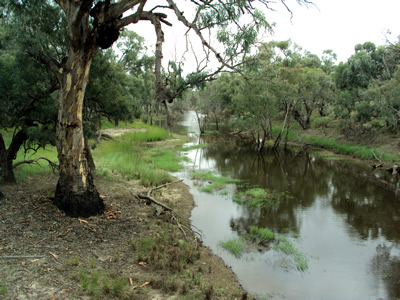
The river red gum, (Eucalyptus camaldulensis) is a common sight along many water courses over much of mainland Australia. It is frequently the dominant tree of riparian communities, and is an iconic species of the Murray-Darling catchment.
Habitat features
River red gum forests provide important habitat for fish, reptiles, mammals and birds. Breeding of many species require a certain length of flooding duration and at the right time of year. The river red gum is a unique ecosystem. It is a monoculture with an absence of shrubs. The understorey is dominated by sedges, rushes, herbs and grasses specifically adapted to the annual pattern of spring flooding and summer drought.
Climate
As spring time temperatures increase, winter snow melts causing floods along the rivers leading from the eastern mountain areas. These floods last for several weeks, even months. The long duration of flooding is very important in regenerating the ecosystem. Eroded silt from the mountains is deposited on the floodplain as the waters slowly meander across the flat floodplain after rushing down the river. Years of deposition has built up the floodplain soil. The floods also wash in plant material adding organic matter to the soil and ecosystem.
A vital breeding ground for fish
With the arrival of the annual flood waters, fish are stimulated to commence breeding. The Murray cod in particular times its breeding cycle to the flooding regime. The female lays her eggs to coincide with increasing water levels and temperature. The juvenile fish or fry then float onto the floodplain where they remain for several months. Amongst the debris they are protected from predators and able to feast on the available food. Without long flood periods the fry will die.
Birds
Wetland birds also utilize the flood period to breed. If water levels fall too soon many adult birds will abandon the nestlings in search of a reliable water pondage.
Gum tree lifecycle
The river red gum themselves respond to the warm temperatures and water supply during spring. They enter a growth spurt stage and develop seeds that are dispersed onto the freshly moistened soil. The resulting seedlings grow rapidly in an attempt to develop a deep enough root system to survive through the long dry summer period.
Location
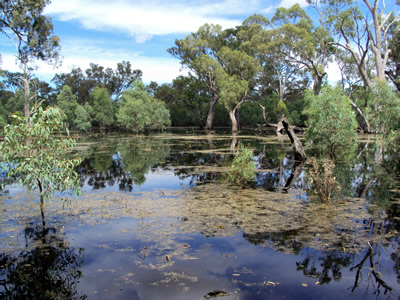
Distribution
River red gum are a widely distributed tree in Australia. They grow along river banks on many inland rivers. Along the Lachlan, Murrumbidgee and Murray Rivers and their tributaries they form large forests. Major forests occur in the area of Wagga Wagga, Deniliquin, Tocumwal and Echuca.
Water
River red gum forests grow on floodplains adjacent to rivers which are subject to flooding. They require over 1100 mm of moisture to remain healthy. Since the Darling, Lachlan, Murrumbidgee and Murray river areas have low rainfall, the rest of the water needs of the forest is provided by the snow melt floods in winter and spring.
Access
Along the rivers there are state forests and reserves that can be accessed for field study purposes. Access and information could be obtained from the relevant government departments and information supplied could be verified by their staff.
Barmah and Millewa
The Barmah and Millewa forests are the most well-known areas of river red gum. The Barmah Forest is on the Murray River floodplain in Victoria between Ulupna Island and Barmah Township. It includes the Barmah State Park and the Barmah State Forest. It is subject to periodic inundation. The forest features a variety of permanent and temporary wetlands, lagoons and forest. These areas provide habitat for a large number of bird species. Berry Jerry state forest is located about 30 kilometres west of Wagga Wagga on the Murrumbidgee River. Access is gained from the Sturt Highway.
Deniliquin
Within the Deniliquin township there is a good area of river red gum reserve on Sanctuary Island and another area just upstream near the sports fields. Both have easy access and are representative of the river red gum ecosystem, particularly as areas with substantial human impacts and conservation measures.
Google Earth
An example of a Red river gum ecosystem lies in the area around the Tocumwal Regional Park by the Murray River on Google Earth. To move out of street view level and look at the wider area click the yellow person icon in the bottom right hand corner. This resource will only work in the Google Chrome browser.
Significance
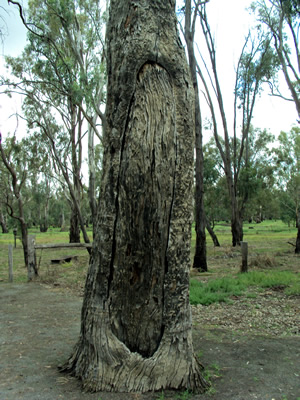
Uses of the wood
The red gum wood has been highly prized for its qualities of termite resistance and strength which make it ideal for construction. Many of the forests have been logged over long periods. The wood from river red gums has historically been used for railway sleepers, building materials, fencing, wood turning, firewood and charcoal.
Impacts of logging
Of critical significance is the effect of past and present logging on the structure of the ecosystem, particularly with the removal of mature and maturing trees from the overall tree population. The ring barking of old trees with no commercial value to allow the regeneration of new growth for future logging has been detrimental to the overall health of the ecosystem in terms of structure and habitat provision.
Source of honey
As a source of honey river red gums are very important. Many bee keepers utilise the forests to produce a high quality honey. Bees can escape the managed hives and colonise the forests occupying hollows that would otherwise be used by native birds or mammals. Hollows in river red gums usually provide habitat for birds and mammals, including the Superb Parrot and Regent Parrot. Only old mature trees develop suitable nesting hollows particularly for the endangered superb parrot.
Fishing
Fishing and other recreational activities such as camping and bird watching are common uses of the river red gum forests.
Conservation
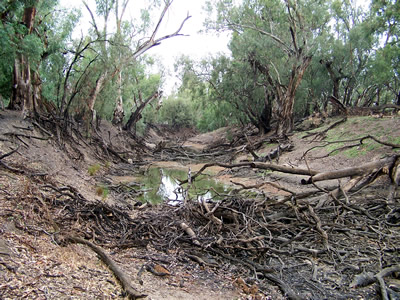
Water regulation
River regulation has resulted in a reduction in both flood frequency and flood duration. Flood duration has been reduced to a few weeks at best while the frequency of floods has been greatly reduced. The resultant decline in river red gum ecosystem health is marked. Few native species, including the trees themselves are breeding successfully or regularly. Native fish species are in decline and without the involvement of managed breeding programs, their very survival is doubtful. For example catfish lay eggs on the substrate. With higher levels of turbidity the eggs are smothered and die.
Causes of destruction
Flood timing affects germination and seedling establishment resulting in reduced growth rates and poor seedling development which in turn affects the overall health of the ecosystem. Rabbits and kangaroos graze seedlings during prolonged dry periods when feed is scarce modifying the original understorey. In some forest areas sheep and cattle grazing is carried out under agistment arrangements. These alter the composition of understorey plants and introduce unwanted and undesired weed species. Feral pigs cause erosion of large areas through digging and wallowing. Shooting is an effective control measure; however this is seen as an inhumane practice by some.
River red gum is very fire sensitive as they lack a lignotuber.
Environmental education centre
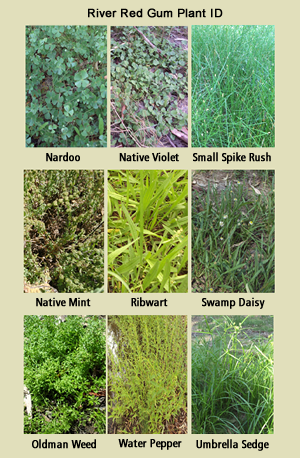
Berry Jerry
The Riverina Environmental Education Centre located in Wagga Wagga provides an ecosystem study of the Berry Jerry site. The study is suitable for senior science and senior geography studies. Berry Jerry is approximately 30 minutes west of Wagga Wagga on the Sturt Highway heading towards Narrandera.
Alternative sites
An alternative study site is located at Darlington Point on the Murrumbidgee River south of Griffith. Staff from the Riverina Environmental Education Centre can also travel to Deniliquin to lead teachers through a study program in the Deniliquin forests. The sites are easily accessible by bus.
The study program and resources
A worksheet is provided for use on the day. Pre-visit and /or post-visit program notes and student self-guided study guides are posted on the web for teachers use. A risk assessment for the study is also available. The study program is the same for both sites with modifications for local variations in conditions, plant species and land use. The web study guide, notes and fieldwork worksheets are suitable for use in any of the river red gum forest areas. Contacting the Centre and discussing your plans is the best way to ensure a trouble free experience whether you decide to lead the study yourself or utilise the services of Centre staff.
Further information
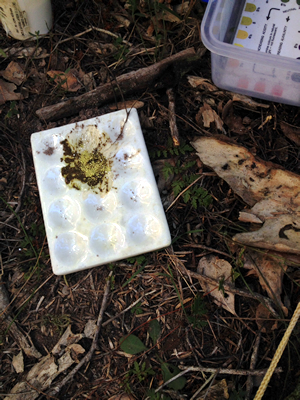
HSC site study
River red gum ecosystems are excellent sites for HSC study purposes. There is ample information available from several sources to compliment the study. The uniqueness of the functioning of the ecosystem provides an excellent platform for students to relate their knowledge in assessment task report form as well as recall, recount and explain in examination situations.
Fieldwork
Fieldwork techniques are comprehensive, easily understood and designed to cover the major components of the ecosystem to enable students to relate the interrelationships that make this a unique environment and a study program of superior quality.
Environmental conditions
The environment can be very hot in summer requiring special attention being paid to the student’s rehydration during the course of the time in the field. In winter the weather can be unpleasantly cold. So attention should be given to student comfort and consider several shorter study intervals with brisk walks between sites to maintain body temperature.
Environmental risks
Red bellied black snakes, brown snakes, wasps and spiders are forest residents and care needs to be taken to ensure no mishaps through unexpected encounters with these and other fauna. The usual First aid kit needs to be carried with qualified persons. The Department guidelines need to be adhered to as on all excursions and at all times.
Useful links
-
Eucalyptus camaldulensis – Wikipedia
-
Water for a Healthy country – River Red Gums, CSIRO
-
Green Preferences – ABC Online, Landline (broadcast 8 August 2010, reporter, Tim Lee)